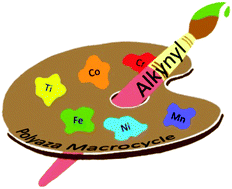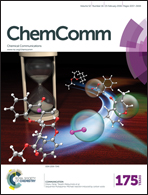Sustainable metal alkynyl chemistry: 3d metals and polyaza macrocyclic ligands
Abstract
We describe the chemistry of 3d metal alkynyls based on polyaza macrocyclic ligands, an emerging area of alkynyl chemistry that has previously been dominated by 4d and 5d metals with soft ligands. The abundance of 3d metals and low cost of tetraazacyclotetradecane ligands make these compounds more affordable, sustainable alternatives to metal alkynyls based on precious metals. Taking advantage of the rich variety of starting materials available in the literature, trans-[M(cyclam)(C2R)2]X (cyclam = 1,4,8,11-tetraazacyclotetradecane) compounds have been prepared from the reactions between [M(cyclam)X2]X (M = Cr, Fe and Co; X = Cl or OTf) and LiC2R. With [Co(cyclam)Cl2]+, both the {trans-[Co(cyclam)Cl]2(μ-(C![[triple bond, length as m-dash]](https://www.rsc.org/images/entities/char_e002.gif) C)n)}2+ and trans-[Co(cyclam)(C2R)Cl]+ compounds have been prepared by a dehydrohalogenation reaction. The latter compounds undergo the second alkynylation reaction to afford dissymmetric trans-[Co(cyclam)(C2R)(C2R′)]+ compounds. Similar alkynylation chemistry with complexes of the cyclam derivatives TMC (1,4,8,11-tetramethyl-1,4,8,11-tetraazacyclotetradecane) and HMC (5,7,7,12,14,14-hexamethyl-1,4,8,11-tetraazacyclotetradecane) has been demonstrated in studies of [Ni(TMC)(C2R)]+ and trans-/cis-[Cr(HMC)(C2R)2]+. Me3TACN (1,4,7-N,N′,N′′-trimethyl-1,4,7-triazacyclononane) is also a supporting ligand that has been observed in transition metal alkynyls. The trans-[M(cyclam)(C2D)(C2A)]+ compounds (D = donor chromophore, A = acceptor chromophore) are excellent candidates for probing photoinduced electron transfer and related photophysical and photochemical processes. 3d Metal ions are often in high-spin ground states, which make these alkynyl compounds promising building blocks for magnetic materials.
C)n)}2+ and trans-[Co(cyclam)(C2R)Cl]+ compounds have been prepared by a dehydrohalogenation reaction. The latter compounds undergo the second alkynylation reaction to afford dissymmetric trans-[Co(cyclam)(C2R)(C2R′)]+ compounds. Similar alkynylation chemistry with complexes of the cyclam derivatives TMC (1,4,8,11-tetramethyl-1,4,8,11-tetraazacyclotetradecane) and HMC (5,7,7,12,14,14-hexamethyl-1,4,8,11-tetraazacyclotetradecane) has been demonstrated in studies of [Ni(TMC)(C2R)]+ and trans-/cis-[Cr(HMC)(C2R)2]+. Me3TACN (1,4,7-N,N′,N′′-trimethyl-1,4,7-triazacyclononane) is also a supporting ligand that has been observed in transition metal alkynyls. The trans-[M(cyclam)(C2D)(C2A)]+ compounds (D = donor chromophore, A = acceptor chromophore) are excellent candidates for probing photoinduced electron transfer and related photophysical and photochemical processes. 3d Metal ions are often in high-spin ground states, which make these alkynyl compounds promising building blocks for magnetic materials.


 Please wait while we load your content...
Please wait while we load your content...